You're here: Main page > 4. History of Eberswalde's trolleybus system > 4.1. Period from 1842 to April 1945
4.1. Period from 1842 to April 1945

A milestone in the history of the public local passenger traffic and thus in the long run
later trolleybus traffic in the city Eberswalde was the link of Neustadt Eberswalde to the
Berlin-Stettiner railway in the year 1842. Since Eberswalde did not show particular interest
in the link to the state railway network, the railway line was led outside of the city. Thus
a requirement of transportation facilities was created.
The transport of the passengers of and to the railway station was executed with horse coaches
and also stage coaches, which drove regularly into the surrounding municipalities.
From the railway station to the city Neustadt Eberswalde led the Eisenbahnchaussee, the
predecessor of the today's Einsenbahnstraße. The Eisenbahnchaussee was a unhitched way.
If was a dirty weather the Eisenbahnchaussee was difficult passable. As the city Eberswalde
didn't like to give money for cobblestone pavement of the Eisenbahnchaussee, the railway
management let pave the Eisenbahnchaussee at his own expense in the year 1860.
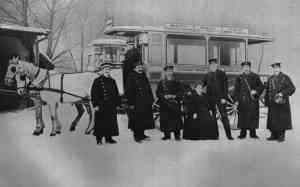 Due to the improvement of roadway conditions the first horse-drawn carriage
traffic in Eberswalde was opened on 01 February 1865.
Due to the improvement of roadway conditions the first horse-drawn carriage
traffic in Eberswalde was opened on 01 February 1865.
After around the turn of the century the nature of the electricity was as
far as possible enlightened and the use of the electricity brought increasingly economic
advantages. First attempts were made to use the electricity in the traffic systems.
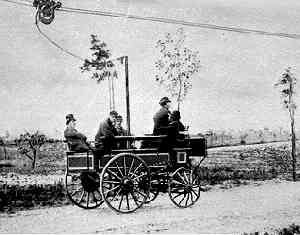 Already on 29 April 1882 Werner von Siemens demonstrated a electric powered horse-drawn carriage in
Halensee near Berlin. This electric powered horse-drawn carriage was named
Elektromote.
Already on 29 April 1882 Werner von Siemens demonstrated a electric powered horse-drawn carriage in
Halensee near Berlin. This electric powered horse-drawn carriage was named
Elektromote.
In the year 1900, thus 18 years later, drove five "trackless trams"
(in German: "Gleislose Bahnen") of the design Lombard Gérin in the exhibition
park of the Paris World exhibition over a 2.5 km long distance. They looked like at this time
common horse buses. The design Lombard Gérin, named after two French technical
designers, was characterised by a motorised trolley that ran synchronously in front of the
trolleybus on the overhead line. This contact car was propelled by an electric motor. The
exhibition jury of the Paris World exhibition decorated the current supply system Lombard
Gérin with a gold medal.
The honor of the current supply system Lombard Gérin with a gold medal of the Paris
World exhibition attracted attention also in Eberswalde. In January 1901 the Berlin engineer
company Johann Friedrich Brandt made a offer to the city Eberswalde for the building of a
trolleybus network with the Lombard Gérin system.
The city Eberswalde gave permission for a three-month test operation from Alsen-Platz to the
forecourt of the state railway station with the chance to get a concession for 30 years and
a further development of the line if the function of the trolleybus network were good.
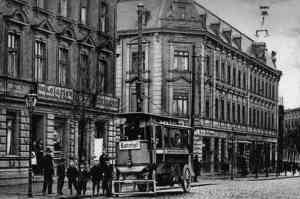 The first test run in Eberswalde began 12 March 1901. On 22 March 1901 was the start of working of the the first trolleybus line in Eberswalde.
The first test run in Eberswalde began 12 March 1901. On 22 March 1901 was the start of working of the the first trolleybus line in Eberswalde.
After 3 months the pilot plant was adjusted because technical lack.
In the year 1904 should be dared briefly a second attempt of the trolleybus test operation
between state railway station and Richterplatz. This is however rather improbable. There are
no details over the test operation (only source "Straßenbahnarchiv", book 6,
page 50).
In Germany the work of Max Schiemann for the development of the trolleybus was vitally
important. Max Schiemann (1886-1933) was the mental father of the "trackless courses", whose
advancement was its life's work. He developed this means of transport further in its own
design engineering department. He created a manufacturing distance and opened on 10 July 1901
a 4 km long distance in Saxonian Switzerland between Königstein and Königbrunn for
the public persons-and goods traffic, the "Bielathal Motorbahn". He developed among
other things contact poles (trolleys) with flexible end pieces for taking off electricity by
the trolleybus overhead lines. They are using also today.
Despite crucial advancements of the trolleybus the Eberswalder aldermen gave on 10. August
1909 their preference for the construction of an electrical tram operation. Decisive among
other things were also the mostly good results of the tram operation in other cities.
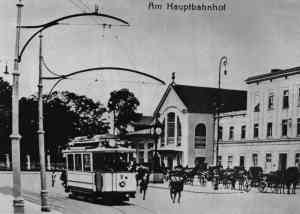 On 01 September 1910 was opened the single-railed distance of the
Eberswalde tram. The operation was executed on a distance by 3,4 km length at the
beginning with 3 trams and led from the Kleinbahnhof across Hauptbahnhof and
Market to Saarstraße.
On 01 September 1910 was opened the single-railed distance of the
Eberswalde tram. The operation was executed on a distance by 3,4 km length at the
beginning with 3 trams and led from the Kleinbahnhof across Hauptbahnhof and
Market to Saarstraße.
First a standardisation and a larger quantity production of vehicles and systems for the
electric trolleybus operation systems were missing in Germany. The advancement of the electric
trolleybuses hesitated out by the World War 1 and the following economic crisis around years.
In the twenties the generation of electricity in Germany could be substantially increased and
this energy be offered for favourable prices. During this time the Rheinisch-
Westfälischen Elektrizitätswerke (RWE power stations) advanced the development of
the electric trolleybus.
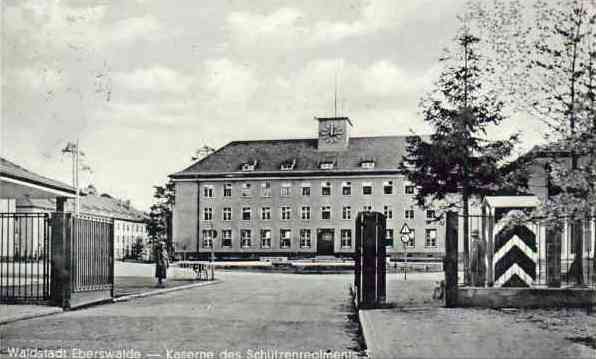 After coming into power of the National Socialist in the year 1933 began an unparalleled armament in the fascist Germany.
So among other things in Eberswalde to Freienwalder Chaussee were built two barracks, one
barracks for an artillery regiment and another barracks for an infantry regiment.
After coming into power of the National Socialist in the year 1933 began an unparalleled armament in the fascist Germany.
So among other things in Eberswalde to Freienwalder Chaussee were built two barracks, one
barracks for an artillery regiment and another barracks for an infantry regiment.
From the year 1936 was strengthened tackled the building of electric trolleybus networks.
Basis for this was an order of the realm ministers for arms- and war production of the fascist
Germany. In the course of efforts of armament fuels should be saved to a large extent
particularly in medium-sized towns.
The Eberswalde Ardelt factories manufactured with priority armaments. The Ardelt factories
recruited skilled workers all over in Germany. Until 1937 the Ardelt settlement was
developed in Ostend.
Due to these factors the passenger numbers of the Eberswalde tram rose strongly and them
achieved in the long run their capacity limit. In addition it came that the terminator points
of the streetcar did not correspond any more with the outermost places of the main traffic
volume. A development of the streetcar or back-up the same was needed.
The following factors spoke against a development of the streetcar:
- The timetable clock could be not further increased due to the single-railed distance.
- Since at the terminal point of transportation only terminals for coupling were available,
thus no turnaround loops, the use of sidecars became difficult.
- The building of further places for evasion was not possible because of the reduced width
of the roads.
- Parking vehicles on the flagship store roads, which would be driven also from the tram,
resulted in a substantial impairment of the traffic flow. The circumstance, that continuously
numerous vehicles were parking here, corresponded to an economic need and could be never
essential restricted.
- The streetcar tracks were prevailing shifted in roads middle and in narrow road sections
partly on one side. They proved ever more than obstacle and showed signs of decay, which made
a global renewal necessary.
- The tramcars would have had to be likewise replaced in some years.
Due to the knowledge of the facts the decision fell in favor of a city transportation without
rails, namely in favor of trolleybus.
The trolleybus received the advantage opposite the motor-bus on the basis of the following
factors:
- The trolleybus possesses well-known advantages, as noiseless, no exhaust gases in the
city, larger liberality etc..
- Due to the characteristic concerning town construction of the city Eberswalde (band city)
the line management was fixed and one was the view, that the line management would in the
future not lose at acceptation.
- The trolleybus drives with domestic energy and the electricity tariff was favorable.
- The available transformer systems of the streetcar could be further used for the
trolleybus.
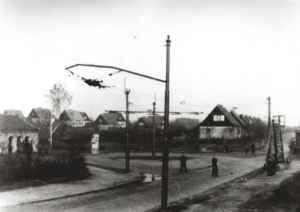 The trolleybus should become the replacement and so the public utilities gave the job for
the building of an electric trolleybus system with single pole
collector in Eberswalde to the company Brown, Boveri and Cie. AG (BBC) Mannheim/Germany on
February,24th 1939.
The trolleybus should become the replacement and so the public utilities gave the job for
the building of an electric trolleybus system with single pole
collector in Eberswalde to the company Brown, Boveri and Cie. AG (BBC) Mannheim/Germany on
February,24th 1939.
The completion of the trolleybus overhead system with single pole collector by the company BBC
prepared large problems.
Actual date was for the start of working 01 January 1940.
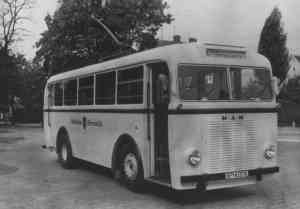 But this goal fell victim to the fact that the delivery of the ordered trolleybuses of the
German type MPE I were not in time.
But this goal fell victim to the fact that the delivery of the ordered trolleybuses of the
German type MPE I were not in time.
In September 1940 for the time being 2 trolleybuses of the 8 ordered trolleybuses were
delivered. These two trolleybuses were used for the reeducation
of the driving personnel.
On 31 October 1940 a limited operation permit for the operation of 7 trolleybuses was given to
the public utilities. The operation permit was terminated until February,1st 1941.
On 03 November 1940 a trolleybus system was start to work in Eberswalde as
compensation for the on 02 November 1940 shut downed tram. The outbreak of the World War 2 and the
adjustment of the industry on arms production delayed it.
The trolleybus traffic was taken up with 5 trolleybuses of the German type MPE I in the 10-
minutes pulse. The price of transportation amounted to 15 Reichspfennige.
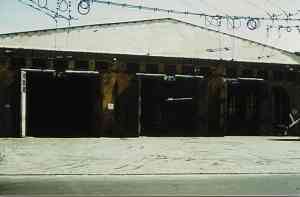 The double-tracked route system has a length of 6,1 km including the branch to the depot Bergerstraße. The double-tracked route ran of Westend over
Boldtstraße, Kleinbahnhof, Hauptbahnhof, market, cemetery, Saarstraße to the
suburban settlement Ostend. At the crossing Freienwalder Straße/Saarstraße was
a double-tracked branch to the artillery-barracks in direction to
Sommerfelde.
The double-tracked route system has a length of 6,1 km including the branch to the depot Bergerstraße. The double-tracked route ran of Westend over
Boldtstraße, Kleinbahnhof, Hauptbahnhof, market, cemetery, Saarstraße to the
suburban settlement Ostend. At the crossing Freienwalder Straße/Saarstraße was
a double-tracked branch to the artillery-barracks in direction to
Sommerfelde.
The branch to the depot was at the Alsen-Platz. The depot was in the former tram hall in the
Bergerstraße. The current supply took place via the transformer system of the former
tram, completed with an electric rectifier.
The rolling stock is extended in August 1941 by 3 trolleybuses and covers in January 1944,
by the purchase of 2 further trolleybuses of the German type MPE I, 10 trolleybuses.
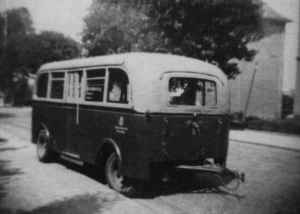 Nine trailers of the company Lindner Ammendorf/Germany completed
the rolling stock of the Eberswalde public utilities. In the year 1942 7 trailers were
delivered and in the year of 1943 further 2 trailers.
Nine trailers of the company Lindner Ammendorf/Germany completed
the rolling stock of the Eberswalde public utilities. In the year 1942 7 trailers were
delivered and in the year of 1943 further 2 trailers.
In calculation of the transport need of the population of the city Eberswalde further 4
trolleybuses were ordered by the company Fahrzeugbau Schumann GmbH Werdau i.Sa./
Germany.
Already in 1943 the World War 2 had have noticeably negative effects to the trolleybus
traffic. Although an enormous transport existed, labor shortage and lack of spare parts
attracted attention to oneself. Trolleybus no. 1 became useless by an cable fire. Therefore
the public utilities asked the supervisory authority for termination of the sunday traffic and
for closing of stops.
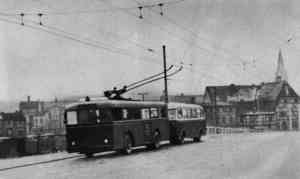 Due to the evacuation of the Berlin Siemens Schuckert factories against end of World War 2 the
last 4 ordered trolleybuses was delivered to Eberswalde. These two
trolleybuses of the German type KEO I (war unit bus standard size 1) were executed in
strongly simplified building method and partly incompletely equipped. They had actually been
built for Leoben/Austria with an 750 V equipment. Since one could not use these however in
Eberswalde, they were parked up to their operation outside of the Eberswalde
depot.
Due to the evacuation of the Berlin Siemens Schuckert factories against end of World War 2 the
last 4 ordered trolleybuses was delivered to Eberswalde. These two
trolleybuses of the German type KEO I (war unit bus standard size 1) were executed in
strongly simplified building method and partly incompletely equipped. They had actually been
built for Leoben/Austria with an 750 V equipment. Since one could not use these however in
Eberswalde, they were parked up to their operation outside of the Eberswalde
depot.
Short before end of World War 2 after the Red Army had crossed the river Oder on 24 April 1945, the city Eberswalde, among other things the depot of the public utilities, became bombed due to the fascist illusion conceptions of the total war and the final victory in the night from 25 to 26 April 1945 by the German (You read correctly!!) Air Force and were destroyed.
However the spearheads of the Red Army were marching past Eberswalde in direction to Berlin.
Only following combat troops occupied on 26 April 1945 Eberswalde and prepared an end for
the fascist despotism.
 The largest section of the depot and workshop burned out. With
this fire, which had have large extents, were 8 trolleybuses completely and 3 trailer partly
burned. They were parked in the depot. A motor-bus was destroyed likewise. Two further
trailers and a defective motor-bus were stolen in war confusions and remained untraceable.
The largest section of the depot and workshop burned out. With
this fire, which had have large extents, were 8 trolleybuses completely and 3 trailer partly
burned. They were parked in the depot. A motor-bus was destroyed likewise. Two further
trailers and a defective motor-bus were stolen in war confusions and remained untraceable.
From the rolling stock remain only few damaged vehicles, 2 trolleybuses, 4
trailers and one other bus. The trolleybus no. 4I was still ready for driving after
"light" repairing. The trolleybus no. 1I was hit by a aircraft bomb and
was still usable only after repair.
The two trolleybuses of the German type KEO I (war unit bus standard size 1), which were
parked up to their operation outside of the Eberswalde depot, survived the bomb attack without
prejudice. They could however still not be used because of missing equipment.
Since also the trolley system was destroyed, the trolleybus traffic was stopped. The
trolleybus overhead system was situated partly absent-minded in the side streets of the city,
because it was aside vacated by the fleeing German military columns and cut thereby. Only in
Ostend and at the artillery barracks gave it still longer intact sections of the trolleybus
overhead.

 Due to the improvement of roadway conditions the first horse-drawn carriage
traffic in Eberswalde was opened on 01 February 1865.
Due to the improvement of roadway conditions the first horse-drawn carriage
traffic in Eberswalde was opened on 01 February 1865.
 Already on 29 April 1882 Werner von Siemens demonstrated a electric powered horse-drawn carriage in
Halensee near Berlin. This electric powered horse-drawn carriage was named
Elektromote.
Already on 29 April 1882 Werner von Siemens demonstrated a electric powered horse-drawn carriage in
Halensee near Berlin. This electric powered horse-drawn carriage was named
Elektromote.
 The first test run in Eberswalde began 12 March 1901. On 22 March 1901 was the start of working of the the first trolleybus line in Eberswalde.
The first test run in Eberswalde began 12 March 1901. On 22 March 1901 was the start of working of the the first trolleybus line in Eberswalde.
 On 01 September 1910 was opened the single-railed distance of the
Eberswalde tram. The operation was executed on a distance by 3,4 km length at the
beginning with 3 trams and led from the Kleinbahnhof across Hauptbahnhof and
Market to Saarstraße.
On 01 September 1910 was opened the single-railed distance of the
Eberswalde tram. The operation was executed on a distance by 3,4 km length at the
beginning with 3 trams and led from the Kleinbahnhof across Hauptbahnhof and
Market to Saarstraße.
 After coming into power of the National Socialist in the year 1933 began an unparalleled armament in the fascist Germany.
So among other things in Eberswalde to Freienwalder Chaussee were built two barracks, one
barracks for an artillery regiment and another barracks for an infantry regiment.
After coming into power of the National Socialist in the year 1933 began an unparalleled armament in the fascist Germany.
So among other things in Eberswalde to Freienwalder Chaussee were built two barracks, one
barracks for an artillery regiment and another barracks for an infantry regiment.
 The trolleybus should become the replacement and so the public utilities gave the job for
the building of an electric trolleybus system with single pole
collector in Eberswalde to the company Brown, Boveri and Cie. AG (BBC) Mannheim/Germany on
February,24th 1939.
The trolleybus should become the replacement and so the public utilities gave the job for
the building of an electric trolleybus system with single pole
collector in Eberswalde to the company Brown, Boveri and Cie. AG (BBC) Mannheim/Germany on
February,24th 1939.
 But this goal fell victim to the fact that the delivery of the ordered trolleybuses of the
German type MPE I were not in time.
But this goal fell victim to the fact that the delivery of the ordered trolleybuses of the
German type MPE I were not in time.
 The double-tracked route system has a length of 6,1 km including the branch to the depot Bergerstraße. The double-tracked route ran of Westend over
Boldtstraße, Kleinbahnhof, Hauptbahnhof, market, cemetery, Saarstraße to the
suburban settlement Ostend. At the crossing Freienwalder Straße/Saarstraße was
a double-tracked branch to the artillery-barracks in direction to
Sommerfelde.
The double-tracked route system has a length of 6,1 km including the branch to the depot Bergerstraße. The double-tracked route ran of Westend over
Boldtstraße, Kleinbahnhof, Hauptbahnhof, market, cemetery, Saarstraße to the
suburban settlement Ostend. At the crossing Freienwalder Straße/Saarstraße was
a double-tracked branch to the artillery-barracks in direction to
Sommerfelde.
 Nine trailers of the company Lindner Ammendorf/Germany completed
the rolling stock of the Eberswalde public utilities. In the year 1942 7 trailers were
delivered and in the year of 1943 further 2 trailers.
Nine trailers of the company Lindner Ammendorf/Germany completed
the rolling stock of the Eberswalde public utilities. In the year 1942 7 trailers were
delivered and in the year of 1943 further 2 trailers.
 Due to the evacuation of the Berlin Siemens Schuckert factories against end of World War 2 the
last 4 ordered trolleybuses was delivered to Eberswalde. These two
trolleybuses of the German type KEO I (war unit bus standard size 1) were executed in
strongly simplified building method and partly incompletely equipped. They had actually been
built for Leoben/Austria with an 750 V equipment. Since one could not use these however in
Eberswalde, they were parked up to their operation outside of the Eberswalde
depot.
Due to the evacuation of the Berlin Siemens Schuckert factories against end of World War 2 the
last 4 ordered trolleybuses was delivered to Eberswalde. These two
trolleybuses of the German type KEO I (war unit bus standard size 1) were executed in
strongly simplified building method and partly incompletely equipped. They had actually been
built for Leoben/Austria with an 750 V equipment. Since one could not use these however in
Eberswalde, they were parked up to their operation outside of the Eberswalde
depot.
 The largest section of the depot and workshop burned out. With
this fire, which had have large extents, were 8 trolleybuses completely and 3 trailer partly
burned. They were parked in the depot. A motor-bus was destroyed likewise. Two further
trailers and a defective motor-bus were stolen in war confusions and remained untraceable.
The largest section of the depot and workshop burned out. With
this fire, which had have large extents, were 8 trolleybuses completely and 3 trailer partly
burned. They were parked in the depot. A motor-bus was destroyed likewise. Two further
trailers and a defective motor-bus were stolen in war confusions and remained untraceable.